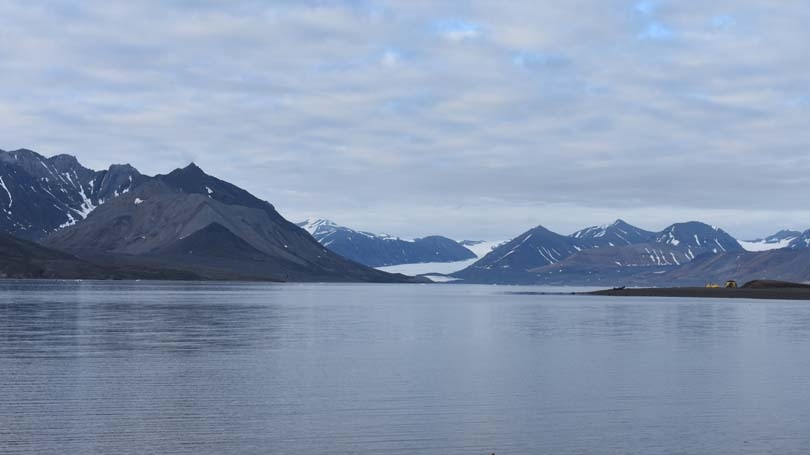
- About
- Application Process
- Fellowships
- News & Events
Back to Top Nav
Back to Top Nav
Back to Top Nav
The rugged, glaciated, coast of Svalbard, Arctic Norway, contains a record of extreme climate changes, the formation and demise of a supercontinent, and the keys to understanding the plate tectonic evolution of the Arctic (Hoffman et al., 2012; Gasser & Andresen, 2013). In 2016 and 2017, I travelled to southwestern Svalbard to sample, map, and document the rock record and uncover the geological history of this small island archipelago. Support from the Alumni Grant Award allowed me to date previously undated rock strata of southwestern Svalbard. These new age constraints have allowed me to piece together the geologic record of southwestern Svalbard over the course of my MSc research with Dr. Justin Strauss in the Department of Earth Sciences.
Since the 1970s, geologists have recognized that the basement rocks on Svalbard record different geological histories from east to west (Harland et al., 1971). Researchers proposed that the island archipelago is made up of three crustal fragments that come from different geographic locations. These crustal fragments are thought to have been transported hundreds of kilometers from their original locations and were juxtaposed approximately 430-390 million years ago (Harland et al., 1971; Gee & Teben’kov, 2004). However, as a result of its remote location, a lack of ages within the stratigraphy, and its internal complexity, the origin and geological history of southwestern Svalbard is debated (Gee & Teben’kov, 2004; Mazur et al., 2009; Gasser & Andresen, 2013). Researchers initially linked southwestern Svalbard to a crustal fragment on northeastern Ellesmere Island, Canada, based on their stratigraphic similarities (Gee & Teben’kov, 2004); however, new geochronological datasets have challenged this link (Gasser & Andresen, 2013). A better understanding of the geological history of southwestern Svalbard from new age constraints is critical to resolving these inconsistencies and providing important context for the tectonic evolution of the Arctic.
For my MSc thesis, I developed a new interpretation of the stratigraphic record of southwestern Svalbard based on field relationships identified during geological mapping in the summers of 2016 and 2017 and new age constraints. In particular, I focused on a unique sequence of stratigraphic layers – a glacially-influenced rock unit that is overlain by a carbonate unit (Czerny et al., 1993). This distinctive sequence can be found in basins all over the world, including Namibia, Canada, and northwestern Svalbard (Hoffman et al., 1998). These sequences are thought to record a time when the entire Earth was glaciated for several million years (Hoffman et al., 1998). While the mechanisms for these climatic swings are still debated, researchers have been able to date the timing and duration of the glaciation in other basins (Rooney et al., 2015; Hoffman et al., 2017) and these sequences can now be used as chronological markers in sedimentary successions.
As part of my MSc thesis, I worked on correlating the glacial successions on southwestern Svalbard to other similar successions through field relationships and carbon isotope analyses. In addition to carbon isotope analyses, funding from the Graduate Alumni Research Award allowed me to perform strontium (87Sr/86Sr) isotope geochemical analyses on limestone and marble samples to date the stratigraphic succession in southwestern Svalbard. The ratio of 87Sr/86Sr in the oceans rose systematically throughout the Neoproterozoic Era (1,000 to 541 million years ago; Halverson et al., 2007). Thus, we can assign ages to Neoproterozoic limestones based off of their strontium isotope compositions. Limestone and marble samples from southwestern Svalbard were analyzed at Yale University’s Metal Geochemistry Center. These new age constraints have helped me confirm that glacial deposits associated with a distinctive global glaciation are exposed on southwestern Svalbard, thereby providing a new age constraint in the previously undated strata of southwestern Svalbard. I would like to thank the benefactors of the Graduate Alumni Research Fund for generously supporting this work.
Acknowledgements
In addition to support from Dartmouth College’s School of Graduate and Advanced Studies Alumni fund, this work was supported by grants from the National Geographic Society, the Research Council of Norway, Dartmouth College’s John Sloan Dickey Center for International Understanding and funding from Dartmouth College’s Department of Earth Sciences.